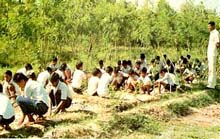What does the Baha’i faith teach about ecology?
 |
 |
 |
A tree planting project undertaken by students at the Rabbani Baha’i School near Gwalior in India. |
One World
‘The earth is but one country, and mankind its citizens.’ These words of Baha’u’llah summarise the Baha’i sense of world citizenship and commitment to stewardship of the earth. The oneness of humanity is, for Baha’is, the fundamental spiritual and social truth of this age. It implies a major restructuring of the world’s educational, social, agricultural, industrial, economic, legal and political systems. Baha’is believe this restructuring will enable the emergence of a sustainable, just and prosperous world civilisation that will exist on this planet for half a million years.
 |
Nature is God’s Will and is its expression in and through the contingent world
Tablets of Baha’u’llah
p 142 |
|
 |
 |
Nature reflects God
The world reflects the qualities and attributes of God, and should therefore be greatly respected and cherished. Baha’i Scriptures describe nature as an emanation of God’s will.
Interconnectedness
All things are interconnected and flourish according to the law of reciprocity. This principle underlies the Baha’i understanding of the way the universe works and the responsibilities of humanity.
Science and technology
Science and technology should help humanity to live in harmony with nature. Science should be guided by spiritual principles, to preserve as much as possible the earth’s bio-diversity and natural order, in a way that ensures long-term sustainability. A spiritually based civilisation in which science and religion work in harmony will preserve the ecological balance of the earth, foster stability in human population, and advance the material and the spiritual well-being of all peoples and nations.
|

